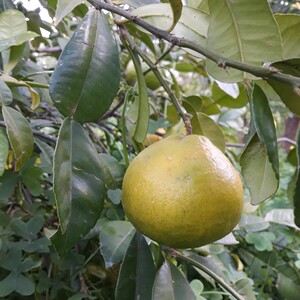Papeda
Melanesian papeda – Satkara
Citrus macroptera Montr.
TCF-306
VARIETAL GROUP
ORIGIN
AVAILABILITY
Papedas and their hybrids
Southeast Asia
September – February

ORIGIN DATA:
This is one of the most wildly distributed papedas in Asia. Its scientific name refers to the morphology of the petiole of its leaves (in Greek: macro, “big”, ptero, “wing”). Also known as Ginger Lime.
TREE AND FRUIT DESCRIPTION:
Moderately vigorous tree of slow growth and with few thorns. Big, wide, lanceolate leaves with large winged petiole and characteristic aroma. Medium sized fruit, the size of an orange, with a pyriform or subglobose morphology, with soft apical mamelon. Very smooth rind, highly attached to the pulp, bright green at the beginning, reaching yellow at maturity. Very aromatic. Green-yellowish pulp, even in the ripe fruit, not very juicy but very aromatic, characterized by its very bitter taste due to the presence of pungent oil. With seeds.
USES:
It is consumed green in September and October, ripe from November to February. In Polynesia, the pulp is used as a shampoo and as a soap for clothes. Both the juice and the leaves, macerated with a little water, form a rich lather used to bleach the hair. In Bangladesh, the juice is used as a condiment in meat and fish stews, and to prepare curry. In Asia, the rind is consumed fresh as a vegetable.




